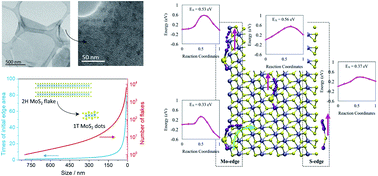Boosting the anchoring and catalytic capability of MoS2 for high-loading lithium sulfur batteries†
Abstract
A high sulfur loading and low electrolyte/sulfur ratio are considered prerequisites for practical high-energy lithium sulfur batteries (LSBs); however, shuttling and the sluggish conversion of flooded polysulfides make it challenging to achieve the full utilization of active materials with an extended cyclic life. Herein, we explore 1T MoS2 nanodots as powerful electrocatalyst to overcome this issue. Electrochemical and synchrotron in situ X-ray diffraction characterizations revealed that 1T MoS2 nanodots with numerous active sites are favored to trap and propel the redox reactions for polysulfides. First-principle calculations indicated that the surface and Mo-terminated edges of 1T MoS2 provide stronger anchor sites for Li2S, a lower Li–S decomposition barrier, and faster Li ion migration than those for the 2H phase, which suggest the unique catalytic property for edge-rich 1T MoS2 nanodots in LSBs. In the presence of a small amount of 1T MoS2 nanodots, porous carbon/Li2S6 cathodes exhibited remarkable electrochemical performance retaining a capacity of 9.3 mA h cm−2 over 300 cycles under high sulfur loading of 12.9 mg cm−2 and a low electrolyte/sulfur ratio of 4.6 μL mg−1, which rivals the performance of the state-of-the-art LSBs. Our combined experimental and theoretical analyses rationalized the use of nanodot catalysts in high energy rechargeable batteries.



 Please wait while we load your content...
Please wait while we load your content...